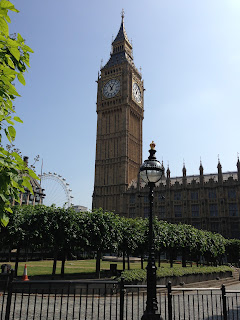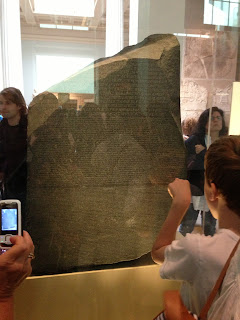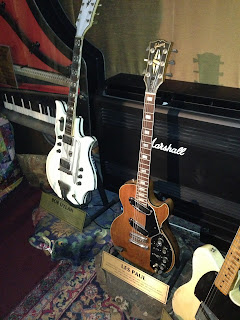Day 14:
 |
| Statue of Shackleton on the "cold" side |
 |
| Statue of Livingstone on the "hot" side |
Today we visited the
Royal Geographical Society (RGS), which is one of the coolest places ever!!!!! On the outside of the building, they have two statues of David Livingstone and Ernest Shackleton on the sides of what they call the "Hot and Cold Corner." We got to talk to the librarian there, and he showed us some of the items from their extensive collection of over 2 million items. Of those 2 million items, half are maps which means they have the largest private map collection in Europe (and maybe in the world). 2000 items are atlases, including their oldest atlas based on the work of Ptolemy and is from Germany in 1490. The picture collection includes 1/2 million pictures, mainly photographs that document the history of British exploration of India, Africa, Central Asia, and the Polar Regions during the 19th and early 20th centuries. Only about 15,000 are digitized, because they tend to digitize on an as-needed basis for user requests or for projects due to budgetary issues. They also have 20,000 glass lantern slides which were used to give lectures and presentations during the 19th century (kind of like PowerPoint is used now). The remainder of the collection includes 250,000 books and periodicals and the archives. The archives consists of letters, logbooks, journals, diaries, correspondence, collections relating to specific people (such as Livingstone) or specific expeditions (such as Mt. Everest), articles, fellowship certificates, membership lists, etc. The smallest part of the collection is, arguably, the most important--the objects and artifacts. They have 1500 artifacts in the collection, and these objects can be borrowed by other museums to go out on exhibit if the borrowing institution agrees to follow strict guidelines for handling and care.
All objects and artifacts are received by donation, but they still buy maps and books to maintain current collections of those materials.
Our guide showed us some of these artifacts and told us the corresponding story for each one. He started with the "Hot Side" and the search for the source of the Nile. The RGS became involved in the search for the Nile's source in the 1850s and sent explorers Richard Burton and John Speke to Africa to see what they could find. They took an Bombay African (an African man living in India), called "Bombay" with them as a guide or helper. The trio started near Zanzibar and headed to Lake Tanganyika, which Burton believed to be the Nile's source. Once they arrived at the Lake, they were ill and needed to stay there to recover from their journey. Burton's recovery took longer than Bombay's and Speke's, so they left him at Lake Tanganyika and headed off to another lake (which Speke called Lake Victoria). This lake was Speke's choice as the source for the Nile. Both explorers returned to the RGS and made their cases to the rest of the Society. The RGS felt that Speke made a better case, so they sent him back on another expedition with James Grant to see if they could prove that Lake Victoria was, in fact, the source of the Nile. They, too, were unsuccessful. Finally in the 1860s, the most famous of the Nile explorers, David Livingstone, was sent into Africa to find the Nile's source. He didn't believe Speke, though, and thought that Lake Tanganyika was the source. He focused his search on Lake Tanganyika, discovered the Victoria Falls, and wandered around unsuccessfully for years without contact with the RGS. Eventually, the RGS sent Henry Morton Stanley, a reporter for an American newspaper, on an expedition to locate David Livingstone. When Stanley found Livingstone, Stanley reports that he said, "Dr. Livingstone, I presume," but there is no record of this exchange in Livingstone's journals or papers. Livingstone died in 1873, and his body was mummified before being sent back to England and buried in Westminster Abbey. Some of Livingstone's maps were the first published maps of a region.
Stanley returned after Livingstone's death and proved once and for all that Lake Tanganyika was not the source of the Nile by following the river all the way to the sea and realizing that it was really the Congo. He then proved that Lake Victoria was the source. He then became connected to King Leopold and the exploitation of the people in the Congo by the Belgians. He, therefore, lost favor with the public.
 |
| Compass the RGS would have sent with Stanley or Livingstone |
 |
| Stanley's boots |
 |
| Stanley's helmet |
 |
| Livingstone's hat |
The librarian showed us how to use a sextant, which is a tool that explorers would have used. In order to measure distance, you point the sextant at the horizon (but you need a clear view of the horizon). If you have an obstructed view, then you would need a second piece of equipment called an "artificial horizon" which includes mercury, a trough in which to pour the mercury, and a cover to make sure the mercury stays debris-free and doesn't spill. There were many sizes of sextants, including a pocket-sized one that could be carried along with you very easily.
 |
| Sextant |
 |
| Box for Artificial Horizon |
 |
| Parts of the Artificial Horizon |
 |
| Smaller Sextant |
 |
| Pocket-sized Sextant |
Another "hot side" story is that of Percy Fawcett (who was born on my birthday in 1867!), who explored South America. He was sent to South America in 1906 and 1909 to create a map and determine a boundary between Argentina and Brazil. He returned and went again to South America in 1925, this time with his son in search of a lost city in the Brazilian rainforest he called "Z." No one knows whether he made it to "Z" or not (or even if the city even exists), because Fawcett, his son, and his son's friend disappeared and were never heard from again.
 |
| Fawcett's map |
From the "Cold Side" of the table, the librarian showed us Inuit boots and a visor that prevents snow blindness, both brought back to RGS by Sir William Edward Parry from his Northwest Passage expedition.
 |
| Inuit Visor |
 |
| Snow Blindness Prevention |
 |
| Inuit Boots |
Another part of the "Cold Side" collection was the materials related to George Mallory and his climb of Mt. Everest. The British became interested in Mt. Everest during their colonization of India. They attempted to map Central Asia, but were not successful except in estimating the heights of the peaks. From the 1920s to 1953 (when the summit was reached by Sir Edmund Hillary and Tenzing Norgay) the RGS sent many expeditions to attempt a successful climb to the summit. However, the most famous was in 1924 when George Mallory and his climbing partner Andrew Irvine headed up toward the peak. Unfortunately, Mallory and Irvine were last seen on 24 May 1924 heading into the distance on the last leg of the climb. Mallory's body was found in 1999 preserved by the cold conditions. No one knows whether they actually made it to the top or not, because his camera was missing. The men who found Mallory's body decided to cover his body with stones and bring his personal effects (goggles, boots, glove, watch, pen knife, box of sweets) back from Mt. Everest, and after some time they ended up at the RGS. They also never found Andrew Irvine's body, but they did find his ice axe near Mallory's body.
 |
| George Mallory's Watch |
 |
| George Mallory's Personal Effects |
 |
| George Mallory's Boot |
Mt. Everest is littered with the bodies of climbers who haven't made it to the top and who have died in the attempt. The conditions on the mountain are brutal, and people can only spend a certain amount of time at the summit because of the lack of oxygen the cold temperatures, the pressure, etc. Climbers first started using oxygen during the 1920s.
Other really cool pictures from our visits to the RGS:
 |
| Ernest Shackleton's Hat (made by Burberry) |
 |
| A chocolate bar, a fox collar, and a biscuit from Franklin's Northwest Passage expedition |
 |
| Washbowl from HMS Erebus |
* * *
In the afternoon, a few of us went to Camden Town to shop and just hang out. We went to the World's End Pub and wandered around the Camden Market for awhile.






































































